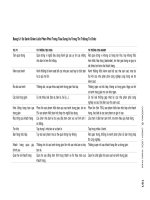Applied C# in Financial Markets phần 7 pdf
Bạn đang xem bản rút gọn của tài liệu. Xem và tải ngay bản đầy đủ của tài liệu tại đây (127.08 KB, 13 trang )
wy042-04 WU042-Worner August 4, 2004 20:49 Char Count= 0
4
Databases
In finance, the need to retrieve or update a database is a key part of most
applications. For those familiar with ADO, the big change from ADO to
ADO.NET is that ADO.NET is a disconnected data architecture. With a
disconnected data architecture the data retrieved are cached on the local
machine and the database is only accessed when you need to refresh or
alter the data. In the futures and options trading system, the requirement
to access the database is constant, from reading product information to
booking trades and positions.
ADO.NET includes classes to handle SQL server and OLE com-
pliant databases such as Access, but to work with ODBC compliant
databases such as Sybase, you will need to download the ODBC .NET
Data Provider from the Microsoft website.
4.1 ADO.NET OBJECT MODEL
DataAdapter and DataSet objects are the two key objects for man-
aging data. The two objects split the logic of handling data into sec-
tions;
DataSet manages the client end and DataAdapter manages the
DataSet with the data source. Data Adapter is responsible for the syn-
chronisation, where applicable, and has the methods to interact with the
database directly.
DataSet is not just representation of data retrieved from a table; it also
handles relationships
DataRelations, Constraints, and Tables
collections. The data cannot be directly accessed through the
DataSet;
instead a
DataTable is returned that contains a collection of Rows and
a collection of
Columns.
Note:
DataSets can also be used to create ‘data source-less’ tables,
which can be handy for client-side temporary data or working with XML
documents.
4.2 CONNECTING TO THE DATABASE
There are several DataAdapter classes: the SqlDataAdapter for
use with Microsoft’s SQL server; the
OleDbDataAdapter for OLE
59
wy042-04 WU042-Worner August 4, 2004 20:49 Char Count= 0
60 Applied C# in Financial Markets
compatible databases (both these are included with Visual Studio .NET);
and the
OdbcDataAdapter used with ODBC compliant databases.
All are instantiated in the same way as shown in Example 4.1 where
a connection is made to a Microsoft SQL server and one to a Sybase
database.
Example 4.1: Instantiating
DataAdapter classes
SqlDataAdapter sqlDA = new SqlDataAdapter
(sqlCommand,sqlConnection);
OdbcDataAdapter sybaseDA = new
OdbcDataAdapter(sqlCommand,sqlConnection);
The relevant references to the database type classes must be included at
the top of the class as shown in Example 4.2.
Example 4.2: References to the various data classes
using System.Data.SqlClient;
using System.Data.OleDb;
using Microsoft.Data.Odbc;
sqlConnection
is the string used to configure the connection to the
database; this varies between providers as to the information that is
required to connect to the databases.
sqlCommand is used topass a string of SQL, such as a stored procedure
name or
sql select
statement.
Once the
DataAdapter has been created, the next step is to create a
DataSet
as a container for the data retrieved as shown in Example 4.3.
Example 4.3: Creating
DataSets
DataSet sqlDS = new DataSet();
DataSet sybaseDS = new DataSet();
Once the DataSets have been created using the Fill method of the
DataAdapter, object rows of data are added to the DataSet as specified
in the
sqlCommand illustrated in Example 4.4.
Example 4.4: Loading the
DataSet with data
sqlDA.Fill(sqlDS);
sybaseDA.Fill(sybaseDS);
Table 4.2 in section 4.5 illustrates how the various classes intercon-
nect.
wy042-04 WU042-Worner August 4, 2004 20:49 Char Count= 0
Databases 61
4.3 CONNECTION POOLS
The overheads of connecting to a database are often higher than running
a short query. With this in mind there are advantages to keeping a num-
ber of database connections alive in a connection pool and returning a
connection when needed.
An abstract class creates and manages the pool and a singleton class
returns a connection. Table 4.1 shows the relation between the abstract
class and the singleton.
Table 4.1 Singleton connection pool
class and the abstract DBConnection class
Connection Pool
getInstance
DBConnection
getconnection
releaseconnection
The constructor of the abstract class
DBConnection (see Example
4.5) creates a number of connections and adds them to an
ArrayList
of connections. There are two public methods: to get a connection and
to release a connection back to the pool.
1
If the request for a connection
is received and there are no more connections available then a new
connection is initialised and added to the
ArrayList. The ability to add
connections when needed is important as the calling objects depend on
getting a connection.
Example 4.5: Database connection management class
public abstract class DBConnection
{
private ArrayList connectionPool = new
ArrayList();
1
This is a very simple example; in practice the initial number of connections and the DSN name would not
be hard-coded but derived from a file. This can be extended to handle a number of different databases and the
methods to get and return a connection would need expanding.
wy042-04 WU042-Worner August 4, 2004 20:49 Char Count= 0
62 Applied C# in Financial Markets
private int nextAvailable = 0;
private const int
initialPool = 3;
//
public DBConnection()
{
initConnections();
}
public OdbcConnection getConnection()
{
nextAvailable++;
if (
connectionPool.Capacity <= nextAvailable)
{
addConnection( nextAvailable);
}
OdbcConnection con = (OdbcConnection)
connectionPool[ nextAvailable];
if (con.State.ToString() == "Closed")
con.Open();
return con;
}
public void releaseConnection()
{
nextAvailable ;
}
private void initConnections()
{
for(int i=0;i< initialPool;i++)
{
addConnection(i);
}
}
private void addConnection(int i)
{
string dsn = "DSN=TradingApp";
connectionPool.Add(new OdbcConnection(dsn));
}
}
With the base class having been written, the next step is to wrap it
around a singleton class as shown in Example 4.6 and this is how the
connection pool holds the connections.
wy042-04 WU042-Worner August 4, 2004 20:49 Char Count= 0
Databases 63
With a default or public constructor, if a new instance of the connection
is created then the connections to the database are created each time thus
defeating the purpose of a pool. With a singleton the constructor is made
private and the only way to get a connection is through the
GetInstance
method, which returns a ConnectPool object that is held or creates one
as required. Note the class access modifier is set to
sealed to prevent
this class being inherited and the constructor or methods overridden.
Example 4.6: Singleton
ConnectPool class
sealed class ConnectPool :
TradingApplication.DBConnection
{
private ConnectPool()
{
}
public static ConnectPool GetInstance()
{
if (con == null)
{
con = new ConnectPool();
}
return con;
}
private static ConnectPool con;
}
The
ConnectPool is created and deployed as shown in Example 4.7.
The
ConnectPool object is created using the method GetInstance,
the connection returned and at the end of the method the connection is
released in the
finally block.
Example 4.7: Connection pool being used in the
dbSelect method
public DataSet dbSelect(string sqlstr)
{
ConnectPool c = ConnectPool.GetInstance();
OdbcConnection con = c.getConnection();
DataSet DSet = new DataSet();
try
{
dbAdapter.SelectCommand = con.CreateCommand();
dbAdapter.SelectCommand.CommandText = sqlstr;
dbAdapter.Fill(DSet);
wy042-04 WU042-Worner August 4, 2004 20:49 Char Count= 0
64 Applied C# in Financial Markets
}
catch (OdbcException dbE)
{
LogError eLog = new LogError(dbE);
eLog.writeErr(sqlstr);
DSet = null;
}
finally
{
c.releaseConnection();
}
return DSet;
}
4.4 DATABASE HANDLER
As the database components lend themselves to a good deal of flexibility,
the downside is that it can be a little complicated. There are components
to drag and drop onto a form to handle data as well as the classes to
communicate directly with the database.
By wrapping up the functionality into a class, as shown in Example
4.8, the database calls can be simplified. There are four methods,
select,
insert,
update and delete
, with the select
method returning the
data as DataSet.
Example 4.8: A database handler class
public class DBHandler
{
// Declare private variables
private OdbcDataAdapter
dbAdapter = new
OdbcDataAdapter();
private System.Data.DataSet
dbDataSet = new
System.Data.DataSet();
//
public DBHandler()
{
}
public DataSet dbSelect(string sqlstr)
{
wy042-04 WU042-Worner August 4, 2004 20:49 Char Count= 0
Databases 65
ConnectPool c = ConnectPool.GetInstance();
OdbcConnection con = c.getConnection();
DataSet DSet = new DataSet();
try
{
dbAdapter.SelectCommand = con.CreateCommand();
dbAdapter.SelectCommand.CommandText = sqlstr;
dbAdapter.Fill(DSet);
}
catch (OdbcException dbE)
{
LogError eLog = new LogError(dbE);
eLog.writeErr(sqlstr);
DSet = null;
}
finally
{
c.releaseConnection();
}
return DSet;
}
public string dbInsert(string sqlstr)
{
ConnectPool c = ConnectPool.GetInstance();
OdbcConnection con = c.getConnection();
string retVal ="";
try
{
dbAdapter.InsertCommand = con.CreateCommand();
dbAdapter.InsertCommand.CommandText = sqlstr;
dbAdapter.InsertCommand.ExecuteNonQuery();
}
catch (OdbcException dbE)
{
LogError logE = new LogError(dbE);
logE.writeErr(sqlstr);
retVal = dbE.Message;
}
finally
{
c.releaseConnection();
wy042-04 WU042-Worner August 4, 2004 20:49 Char Count= 0
66 Applied C# in Financial Markets
}
return retVal;
}
public string dbDelete(string sqlstr)
{
ConnectPool c = ConnectPool.GetInstance();
OdbcConnection con = c.getConnection();
string retVal ="";
try
{
dbAdapter.DeleteCommand = con.CreateCommand();
dbAdapter.DeleteCommand.CommandText = sqlstr;
dbAdapter.DeleteCommand.ExecuteNonQuery();
}
catch (OdbcException dbE)
{
LogError logE = new LogError(dbE);
retVal = dbE.Message;
}
finally
{
c.releaseConnection();
}
return retVal;
}
public string dbUpdate(string sqlstr)
{
ConnectPool c = ConnectPool.GetInstance();
OdbcConnection con = c.getConnection();
string retVal ="";
try
{
dbAdapter.UpdateCommand = con.CreateCommand();
dbAdapter.UpdateCommand.CommandText = sqlstr;
dbAdapter.UpdateCommand.ExecuteNonQuery();
}
catch (OdbcException dbE)
{
LogError logE = new LogError(dbE);
retVal = dbE.Message;
wy042-04 WU042-Worner August 4, 2004 20:49 Char Count= 0
Databases 67
}
finally
{
c.releaseConnection();
}
return retVal;
}
}
4.5 WORKING WITH DATA
Those of you familiar with ADO will need to move away from the
RecordSet concept of .moveFirst,.moveNext and .moveLast as
this is done differently in ADO.NET.
Rather than iterate through the
DataSet object directly there is a
series of collections that need accessing; the hierarchy is illustrated in
Table 4.2. The
DataSet has a collection of Tables; these in turn contain
a collection of
Rows and Columns. The Rows collectioncan be referenced
by item or by number.
Table 4.2 The hierarchical relationship between DataSet, DataAdapter and the
Tables, Rows, and Columns
sqlDataAdapter
OleDataAdapter
OdbcDataAdapter
DataSet
Tables
Rows
Columns
Example 4.9 shows how a DataSet is created, the DataRow extracted
and the item read and stored into a string.
Example 4.9: Extracting data from a
DataSet, Table, and Row col-
lection
DataSet ds = pHandler.getDataByAcctCategory
("trading");
wy042-04 WU042-Worner August 4, 2004 20:49 Char Count= 0
68 Applied C# in Financial Markets
DataRow dr = ds.Tables[0].Rows[this.gridPositionTrade
.CurrentRowIndex];
string cat = dr["category"].ToString();
Because the architecture is disconnected
DataTables
can either be
created or derive from a query.
DataColumns represent the columns of
data and form a collection contained in the
DataColumnCollection.
DataRelations
represents relationships between tables through
DataColumn objects. The DataSet object has a
relations property
which returns a
DataRelationCollection. The DataRelation sup-
plies a rich array of functionality but it does depend on well-defined
indexed relational data.
4.6 TRANSACTIONS
In this section we look at how the DataAdapter keeps the records syn-
chronised with the database. There are a number of methods that you may
use to update or insert a record. The
DataAdapter has InsertCommand,
UpdateCommand and DeleteCommand to process the updates, inserts or
deletes.
C# has a number of methods to update the database. For proto-typing,
dragging and dropping components onto a Windows form and linking
them directly to a grid will create a quick way of viewing and updating a
database. However, for scalability and use within Enterprise applications
the direct method of accessing the database is preferred, as the solution
will be more compact.
This section will concentrate on the direct approach of creating a
command or calling a stored procedure and executing it.
Looking at an update transaction in detail, as shown in Example
4.10, the
UpdateCommand method of the DataAdapter is initialised
with the
CreateCommand from the ODBC data connection. The next
step is to assign the
CommandText property the string of SQL or the
name of the stored procedure and any required parameters. Finally, the
ExecuteNonQuery method is called.
Example 4.10: An update method
public string dbUpdate(string sqlstr)
{
ConnectPool c = ConnectPool.GetInstance();
OdbcConnection con = c.getConnection();
wy042-04 WU042-Worner August 4, 2004 20:49 Char Count= 0
Databases 69
string retVal ="";
try
{
dbAdapter.UpdateCommand = con.CreateCommand();
dbAdapter.UpdateCommand.CommandText = sqlstr;
dbAdapter.UpdateCommand.ExecuteNonQuery();
}
catch (OdbcException dbE)
{
LogError logE = new LogError(dbE);
retVal = dbE.Message;
}
finally
{
c.releaseConnection();
}
return retVal;
}
As discussed earlier there are several methods to update data in
C#, from using the visual drag and drop on forms to hand-coding
the direct communication to the data source. There is a ‘middle’
way of manipulating the data in a
DataSet as C# provides a way
of updating the data using the
DataSet class and the GetChanges
method.
DataSet also contains the
HasErrors property to ensure data
integrity.
Example 4.11 shows how to update the database by passing the
DataSet to the DataAdapter.
Example 4.11: Updating the database with a
DataSet
dataAdaptDet.Update(ds,"Positions");
The Update method is not the final step as the AcceptChanges or
RejectChanges methods must be called. Failure to do so means
the
DataSet will always have the changes flagged and when the
DataAdapter is called it will try and commit them. This allows for error
handling, as shown in Example 4.12, by placing the methods around a
try/catch block, and calling the RejectChanges if a database error
is thrown.
wy042-04 WU042-Worner August 4, 2004 20:49 Char Count= 0
70 Applied C# in Financial Markets
Example 4.12: Committing changes to the database
try
{
dataAdaptDet.Update(ds,"Positions");
ds.AcceptChanges();
}
catch (OdbcException dbE)
{
ds.RejectChanges();
MessageBox.Show(" Update not successful " +
dbE.Message);
}
4.7 WORKSHOP: EXERCISE THREE
By completing the first two exercises you have a working options cal-
culator that allows a trader to input the required parameters to value an
option and then choose the model.
By introducing databases we now have a way to read from and
write to a database, thus reading products created by another process
and publishing prices to the database for possible use by another ap-
plication.
In this chapter we have examined in detail how connections are made
and how they can be handled with a pool, and how the database interac-
tion may be wrapped up in a class.
At this point it may be useful to refer back to Example 4.6 for the
connection class, Example 4.7 for the connection pool, and Example 4.9
for the database handling class. These are available to download, details
of which are shown in Appendix C.
In this exercise we will concentrate on using these classes in the con-
text of our options calculator application. You will learn how to extract
the details of an option from a pull-down list from the database, and
pre-load some of the parameters such as stock price and volatility. The
exercise will familiarise you with the disconnected data environment,
and the interaction between
DataAdapter and DataSet. See Table 4.3.
First, create the connection and database handler classes. Then create a
combo box on the form that displays the option description. On selection
of an option, populate the stock price, volatility, risk-free rate, and put
or call type fields.
wy042-04 WU042-Worner August 4, 2004 20:49 Char Count= 0
Databases 71
Table 4.3 Data schema for Exercise three
tblOption
symbol string
name string
strike string
volatility double
underlyingPrice double
riskFreeRate double
putCall string
To handle the data retrieval it is better to encapsulate the behaviour
into a class, then assigning values to the form components should be
done in the form methods.
The complete code for the models and the sample calculator can be
downloaded at
Please
follow the instructions on the website on how to download the code.
4.8 SUMMARY
Databases are at the centre of every finance application, and begin-
ning with the overview of ADO.NET and connecting to the databases
we have seen how the architecture is built around a disconnected data
model.
There are two sets of Data Adapter classes that are included in the
Visual Studio .NET IDE, one specifically for Microsoft’s SQL server,
the other for compatible relational databases. However, to use other
databases through an ODBC, the ODBC .NET Data Provider needs
downloading and adding to the project.
Connecting to databases may take up more resources and time than
running a reasonably short query to a database. By creating a pool
of connections the connections are held and managed by a singleton
class.
The database handler class was looked at to simplify the data access
methods; by encapsulating the steps needed to retrieve and modify data
in a single class the various steps required are hidden.
Working with a disconnected data model, ADO.NET is different to
the ADO model of moving through datasets. The collections
Rows and
Columns are held in the DataSet class.









